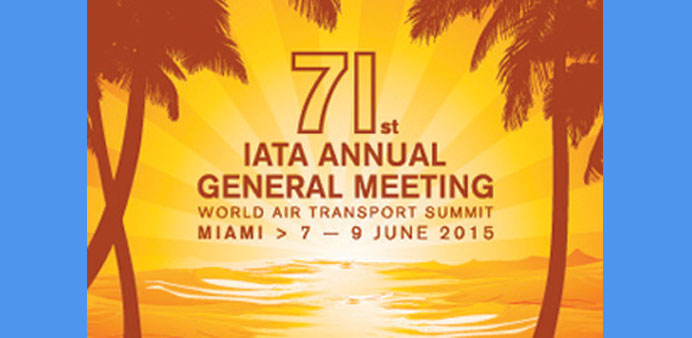By Pratap John/Chief Business Reporter /Miami, Florida
The International Air Transport Association (IATA) began its three-day annual meeting here on Sunday against the backdrop of a plethora of issues facing the industry including aircraft financing, limited airport capacity in many countries, slowing air freight momentum and the open skies row between three major Gulf carriers and airlines based in the US.
IATA figures show the demand in the passenger segment was robust in 2014. With a 5.9% expansion of demand, the industry out-performed the 10-year average growth rate.
Carriers in the Middle East led by Qatar Airways, Etihad and Emirates have posted double-digit growth, while results in Africa were barely above previous-year levels. Overall, a record 3.3bn passengers boarded aircraft last year: some 170mn more than in 2013.
Latest figures released by the global trade body of 250 airlines also showed improved passenger traffic in April compared with the same period in 2014.
Total revenue passenger kilometres (RPKs) rose 5.9%. April capacity (available seat kilometres or ASKs) increased by 6.1%, and load factor slipped 0.1 percentage points to 79.4%.
Domestic demand grew by 7.2%, outpacing international demand which grew by 5.2% compared to April 2014.
On the other hand, the air freight business saw slowing momentum in April compared to a year ago. IATA has estimated that despite a cyclical pick-up in the global economy, acceleration in trade and air freight demand is unlikely in the near term as business confidence and export orders are either flat or declining.
Today, the air transport industry is a vital driver of the global economy. IATA estimates that about 1% of global GDP is spent on air travel. Including direct taxation, that will be a total spend of $823bn this year.
For that, IATA anticipates that 3.5bn people will travel and 53.5mn tonnes of cargo worth some $7.3tn will be transported. Air travel accounts for some $644bn in tourism receipts. And the industry supports jobs; some 58mn worldwide with a total economic footprint of $2.4tn.
Funding the growth of the industry, especially in the context of rising travel demand in two major economies – China and India, remains a major challenge to stakeholders and policymakers alike.
Analysts expect the three-day annual general meeting of IATA at the historic Loews Miami Beach Hotel to see some discussions on the “open skies row” between the three major Gulf Cooperation Council carriers and some airlines based in the US.
United, Delta and American airlines, in particular claim that Emirates and Etihad, both based in the UAE, as well as Qatar Airways receive billions of dollars in subsidies from their respective governments. This leads to unfair competition, they argue. The three Gulf airlines have denied such accusations and termed these utterly baseless.
The pressure exerted on the Obama administration, reportedly by three major US carriers to renegotiate the open skies treaties with the two home countries of three major GCC carriers, however, does not go well the proclaimed US policy of open skies around the world.
Data indicate the US has signed more than 100 open sky treaties since 1992 and gained significantly by growing traffic, increasing revenues and creation of thousands of jobs, directly and indirectly.
The first one to dismiss such accusations was Qatar Airways Group chief executive Akbar al-Baker, who said they (US carriers) need to understand the difference between government subsidies and government equity.
The GCC region’s aviation industry has had a phenomenal growth in the last three to four decades, thanks to economic boom, investible surplus and a growing population.
Emirates, Etihad and Qatar Airways have capitalised on these and grown amid stiff competition from bigger airlines based in the US or Europe.
The growth of the Big Three Gulf airlines has a direct beneficiary based in the US: the Chicago-based planemaker, Boeing. Along with its European rival Airbus, Boeing has filled its order book with commitments from Emirates, Etihad, and Qatar Airways. It is no secret that the substantial orders placed by the Gulf carriers have helped Boeing maintain growth and employ thousands of people across the US.
United, Delta and American Airlines are among the largest carriers in the world. They were all founded in the 1920s by aviation pioneers and were instrumental in shaping up the global aviation industry. They also benefit from a highly developed and technologically superior market that has a wealth of skilled manpower — mechanics, engineers, and pilots. The sheer size of the North American market provides them tempting opportunities for growth, both domestically and internationally.



